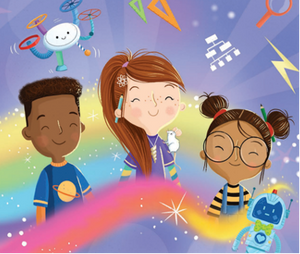For parents or teachers who are looking to inspire their budding little physicists and engineers to learn more about STEM and to develop a STEM learning mindset, we have some hands-on and practical off-screen activities to try out at home or school with your little ones. We call these bite-sized STEM learning activities, STEM quests.
Today your children are on a very important mission. As avionics engineers their challenge is to design and create a plane that glides the farthest. Just like avionics engineers, they will work on designing, building, testing, and controlling machines (paper planes) that fly (glide). This is going to exercise their trial and error and solution evaluation skills which are part of structured problem solving.


For this STEM quest, Children are free to use any materials that they find around the classroom or at home and are encouraged to be as creative as possible.
Step 1: Decide on which type of plane to make and complete a sketch
A great way to start is by asking the children to sketch out some ideas on a piece of paper. Sketches can be simple or complex depending on their age. Starting with a very simple sketch helps to start from a basic and solid basis which is going to be their reference point. Later on, the sketch can be improved and made more complex, for example, with the addition of wingtips. Wingtips are upward folds at the end of the wings, which can help your plane to achieve a smoother and straighter flight path.
Step 2: Explore and decide on materials to use
Think about materials to use in making their planes. Get them thinking about different types of materials and how this might impact the design and performance of their planes. For example, they can use cardboard, parchment paper, aluminium foil, or glitter paper. You can ask the children what they think the result might be if they use a heavier paper (e.g. cardboard) versus a light paper (e.g. parchment paper). You can also ask where it is important to fold the material to have a more solid plane. For example, adding folds to the plane strengthens the structure of the plane.
Step 3: Collect all the materials needed
Search out all the materials needed to build the planes with what you have available at home or in the classroom. Let the children determine what can be used and should not be used and why. It is important to let them fail, for example using tissue paper, as it is part of the learning experience. In case of failure, ask them why it failed, what they think about it and what they could do different for the next attempt.
Step 4: Create first prototypes.
Prototypes are original forms of a design idea and are often used for testing and further design improvements. Prototypes vary from the shape of the plane, where to fold, how many times to fold, etc. The idea is that children create several different prototypes out of diverse materials (e.g. paper of diverse weights and textures like white printer paper vs. construction paper vs parchment paper or carton or foil, etc.) and designs. During this phase children use trial and error to determine which materials, designs and sizes seem to work best.
Step 5: Competition time!
All planes are tested in a mini competition and distances are measured and recorded by the official panel (parents and siblings or teachers at school).
The winner is the plane that has flown the furthest. Bonus points can be awarded for creativity and design.
This quest can be simplified or made more complex depending on the age and development level. The quest focuses on predicting behaviour via experimentation and developing a continuous improvement mindset via testing and improving over and over to their plane design, in order to achieve better results. These are all skills that will help your children to develop a scientific mindset and better problem-solving skills.
At QuestFriendz we believe that imaginative and hands-on purposeful play, when combined with problem-solving through play, are key to providing young children with an engaging and memorable experience. Starting STEM at an early age helps children to make important connections between everyday life and the STEM disciplines. Addressing young children also allows us to harness their natural curiosity. This magical state helps to accelerate learning including STEM learning. Children become better equipped to face a fast-paced and evolving world, when problem-solving skills and learning to fail are introduced from a young age.
We’ll be sharing some more of our favourite STEM educational quests for parents to try out with their kids at home or for teachers to try in the classroom. Stay tuned!








